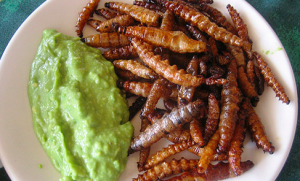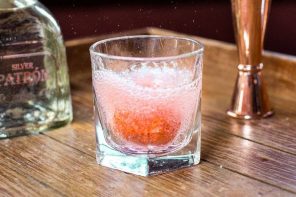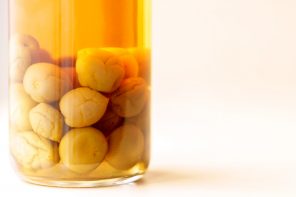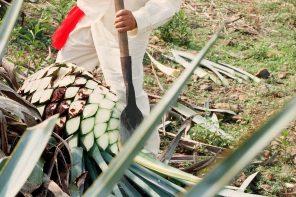Over the course of history, humans have been known to put all sorts of questionable things into their drinks. There is no end to the amount of ingredients that can (and will) be mixed up in a glass and served to unsuspecting (and willing) drinkers. As any child who has mixed up a “suicide” with every soda at the fountain can tell you, beverages fueled by boundless creativity can be hit or miss.
Mezcal is one of the booze universe’s most recent smash hits, and it too contains an ingredient most would regard (at a minimum) as questionable: a plump little worm.
Given that most producers of fine beverages actively strive to keep dead insects out of their product, the recent popularity of Mezcal leads us to ask- what is up with the worm?
There’s some debate surrounding the purpose of those little moth larvae, and we are here to address all possible answers to one of life’s most important questions: why is there a worm in Mezcal?
1) The worm is added for flavor!
This is the claim that all worm-using Mezcal producers make. In southeastern Mexico, certain larvae are roasted and eaten as seasonal specialities. These larvae are the same kind of larvae that fail swimming lessons in your bottle of Mezcal. The most commonly used larvae are red worms (gusano rojo) and maguey worms (chinicuil), which are also considered to be the tastiest edible larvae around.

Roasted Chinicuiles- get ’em before they’re pupa!
So do these moths-never-to-be really add something to the drink? Well, Mezcal is a complex spirit with several layers of flavor and a strong, smokey backbone. Given how much is going on in the beverage, it’s certainly possible that these worms add some sort of “something” to the overall taste, but unlikely.
Plenty of Mezcal producers don’t use the worm, and put forth an extremely similar product. Plus, most producers cure their worms in pure alcohol before bottling, which gives us reason to believe that they don’t add too much as far as flavor goes. Could the worm be included solely for marketing reasons? Stranger things have happened…
2) The worm will give you powers!
Around this globe of ours there are those who believe that by drinking a spirit that contains the “essence” of a certain animal, some of the powers and characteristics of that animal are taken on by the drinker. These beliefs aren’t as prevalent in Mexico (at least these days) but are alive in well in Asia, where snake wine is believed to increase potency and is marketed as a cure for all sorts of ailments.
Whether or not you believe that a beverage like snake wine or worm-infused Mezcal will come with “essential” benefits, one might wonder why anybody would want to take on the characteristics of a larva. That is, until you remember that one day those infant caterpillars would have blossomed into a big old furry moth, which would be fun for a day or two.
3) Revenge!
Nobody has ever said “revenge is a dish best served in a bottle of Mezcal,” but it just might be true. Most producers use chinicuil or gusanos rojos for their supposed flavor benefits. Others however, use picudo del agave worms, which are the larvae of the Agave Snout Weevil.
As it turns out, the Agave Snout Weevil is a pest that preys upon agave plants. Agave plants are the very plants used to make Mezcal and its cousin Tequila. Are harvesters and producers deliberately putting the corpses of their weevil foes in their beverages to send a message? Probably not. But then again, you can’t really rule it out, can you?









Even in the 1950’s there was a worm in a bottle of mescal. I’ve seen Mexican Americans eat it with relish!
We were told by our Mexican hosts down in Baja that the gusano was proof of the plant the mezcal came from, and not some knock-off cacti.
Whatever, by the time you reach the worm, it’s the last shot. By that time you don’t care there’s a worm in your glass!
Hey Hayes….Mezcal is from the other side of the tracks….its sort of like Jim Morrison at the Florida concert vs The Muppets at Radio City Music Hall. The worm is there to provide quality control: If the worm dies its muy bueno caca!!!
[email protected]
Nice story…….back in the 70’s a walk across the border of Juarez, Mexico I brought back a mini bottle of tequila with a salt packet tied to the rim and a worm in the bottom. Then it was said that you got the worm that absorbs all the alcohol…… In Chili they put fruit in the wine that supposedly absorbs the alcohol. Either way was considered a better high than just drinking without.
Ok, now I have more unanswered questions. Can we get a definitive answer that’s more scientific than speculative about this little worm?
Hey Dole! I’m so glad you asked. The worm in mezcal is considered by most experts to be a gimmick intended to grab the attention of tourists. However, some people do really enjoy eating the worm and others will be adamant in telling you that the little guy does give you special powers. Unfortunately, you’d be hard put to find a bottle of mezcal in the US that has a worm in it, but if you ever find yourself south of the border definitely knock one of them back and let us know what you think!
Good eating!
Ha, been there done that, I was eating worms when I was 2 years old.
I reckoned that it sent the message; if you had worms, that stuff would kill them, or If you don’t have worms, it will prevent them.
The worm is a marketing device, pure and simple. One usually sees a worm in bottles of mezcal destined for tourist purchase. “Oooh, look, there’s a worm in that bottle you brought back from Mexico! Wow, should we eat it?”
And Dole, not all mezcal is smokey, nor should it be. The really best sipping mezcales aren’t. Come visit me in Mexico City and you can try more. You’ll be amazed at how good mezcal is when you can taste more than a heavy, smokey top note.
I’m pretty sure that the worm ridding elixer is absinthe due to the use of artemesia in the recipe. Those poor moth larvae aren’t worms, they’re more like caterpillars.